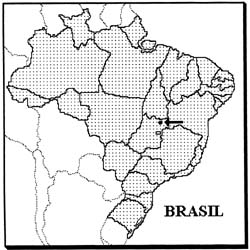|
Phragmipedium chapadense Campacci & Takase sp. nv.
Description:
Terrestrial plant with short rhizome, witish roots, glabrous,
with about 3,0 mm in diameter. Coriaceous leaves, in the uper
side slightly canaliculate, underside carenate, reaching 50,0~
60,0 cm in length and 2,0~3,0 cm in width, dark green in the
surface and ligther in the underside with no yellow margin.The
inflorescence is brown, reaching 50,0 cm in hight, pilose bearing,
light green bracts of 10,0 cm. Floral bracts longer than ovary,
6,0 ~7,0 cm in size, also light green in color with a darker
green venation in the surface.
Successive flowers (3 to 5) with 10,0 cm total vertical length
by 13,0 cm total horizontal length. The dorsal sepal is ovate-lanceolate
in shape, measuring 5,0 ~ 5,5 cm long by 1,5 ~ 1,8 cm wide, acuminate,
yellow-green in color with brown venation, and in the back side
is darker than the synsepal. The synsepal have the same color
as the dorsal sepal, also veined, but darker in the border, measuring
4,5 ~ 4,8 cm long by 3,2 ~3,4 cm wide and slightly undulated
in the border. Linear-lanceolates petals, longer than the sepals,
measuring 9,0 cm longer by 0,7 ~ 0,8 cm wide near the base and
geting thiker to the end. The color of the petals is ligth green
in the center with red margin bearing paralel stripes of red-brown
color. Near the base they are undulated and pilose, with one
or two full twists. The apices of the petals are pilose with
intense red color. They held a 45° position below the horizontal
line.
The lip is longer than the synsepal, measuring 5,0 ~5,2 cm long
by 2,4 ~2,5 cm wide, sacate in general obovoid. The pouch is
wider than the infolded side lobes, chestnut greenish in color.
It bears two auricles in the margins of the aperture. The side
lobes (ostio) are pale green spotted with small redish-brown
dots, without other acessory spots. The joint of the side lobes
is brigth green in color. Elliptic staminode, measuring 0,6 cm
long by 1,0 cm wide, brigth green with short thik redish hairs
in all the uper side untill the collumn and the external border
turned backside. The collumn is pubescent and has 0,4 ~0,5 cm
long.
HABITAT : It grows in open grassy fields and depressions
over seepage covered by a shrubby vegetation.
DISTRIBUTION : Chapada dos Veadeiros, State of Goiás, Brazil.
At an altitude of 700 - 900 m.
FLOWERING SEASON : In Brazil this species flowers at the
end of summer.
COMMENTS : This species was usually confused with Phrag.
vittatum (Vell.)Rolfe by collectors, but differs from
the latter in many points, i.e. appearance of the plant, being
considerably smaller in size, having a larger, near elliptic
staminode etc.; whereas Phrag. vittatum has an
apparent triangular staminode. Petals are not pendent downwards
like those of Phrag. vittatum, but deflected at
about 45 degrees angle from horizontal. Besides, the flower scape
is always shorter and darker.
The flowers are somewhat similar to those of Phrag. hartwegii
(Rolfe)Pfitzer from Ecuador concerning coloration of the petals,
its narrow infolded side lobes, the shape of the flower bract
and the colour and form of the ovary. However the differences
from Phrag. hartwegii are clear: In Phrag.
chapadense the pouch is wider than the infolded side lobes,
while in Phrag. hartwegii these two parts are equal
in width; the staminode of Phrag. chapadense is
elliptic in shape and black hairs on the upper margin are conspicuous,
whereas in Phrag. hartwegii subcordate, a little
smaller and hairs, being located further backward and hence not
so remarkable. Colour of the pouch of Phrag. chapadense
is maroon, while greenish or yellowish in Phrag. hartwegii.
Further, the size of Phrag. hartwegii is generally
larger than that of Phrag. chapadense.
|
020408
